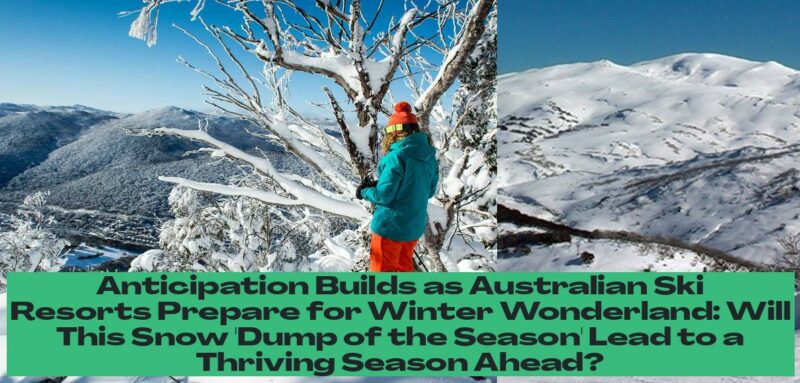Australian Ski Resorts Gear Up for a Snowy Season
The anticipation is palpable in the air as Australian ski resorts gear up for the upcoming winter season. While the lack of significant snowfall in the early months has raised concerns, the recent “dump of the season” at Hotham has ignited a wave of excitement. The resort, renowned as one of the largest in the country, recorded an impressive 31 centimeters (12 inches) of fresh snow in the past week, with an additional 50 centimeters (19.7 inches) expected in the coming days. This significant snowfall has injected a much-needed boost into the ski industry, creating a buzz of excitement among snow enthusiasts and resort operators alike.
The recent snowfall at Hotham is a welcome change after a relatively dry start to the season. The lack of snowfall earlier in the year forced many resorts to rely heavily on artificial snowmaking to ensure a decent ski experience for visitors. However, the recent natural snowfall has provided a much-needed reprieve, allowing resorts to focus on preparing for the influx of skiers and snowboarders expected in the coming months.
The Australian ski industry is facing a future of uncertainty due to the impact of climate change on snowfall patterns. The nation’s top science research body has warned that maximum snow depths are plummeting, leading to shorter seasons and a less predictable ski experience. This poses a significant challenge for resorts, as they need to adapt to changing conditions and ensure their continued viability in the long term.
Despite the challenges, Australian ski resorts are determined to offer a world-class experience for visitors. They are investing in innovative technologies and sustainable practices to mitigate the impact of climate change and maintain the quality of their offerings. This includes investing in snowmaking infrastructure, improving snow removal techniques, and working with local communities to promote sustainable tourism practices.
As the winter season approaches, ski resorts across Australia are preparing for a flurry of activity. From the iconic peaks of the Snowy Mountains to the picturesque slopes of Tasmania, the country’s ski destinations are gearing up to welcome skiers and snowboarders from around the world. With the recent snowfall at Hotham setting the stage, the Australian ski industry is poised for an exciting and action-packed season.
The Importance of Snowmaking in the Australian Ski Industry
While natural snowfall is always a welcome sight, the reality is that Australian ski resorts have become increasingly reliant on artificial snowmaking to ensure a consistent and enjoyable experience for visitors. The unpredictable nature of snowfall in Australia, coupled with the growing impact of climate change, has made snowmaking a vital tool for the ski industry’s survival.
Snowmaking technology has come a long way in recent years. Modern snowmaking systems utilize advanced technology to create high-quality snow that is comparable to natural snowfall. The process involves using high-pressure water cannons to spray a fine mist of water into the air. As the water droplets freeze, they form tiny ice crystals that accumulate on the ground, creating a layer of snow. The efficiency of snowmaking systems has improved significantly, allowing resorts to create snow even under relatively warm conditions.
The use of snowmaking has its advantages and disadvantages. One of the major benefits is that it allows resorts to extend the ski season, providing skiers and snowboarders with more opportunities to enjoy the slopes. Snowmaking also ensures a consistent snow cover, even in years when natural snowfall is limited. This is particularly important for resorts that rely on tourism revenue, as it allows them to provide a reliable experience for visitors. However, snowmaking has been criticized for its environmental impact, particularly the use of water and energy. Many resorts are working to minimize their environmental footprint by using efficient snowmaking equipment and adopting sustainable water management practices.
The future of snowmaking in the Australian ski industry is inextricably linked to the challenges posed by climate change. As temperatures rise and snowfall patterns become more unpredictable, the role of snowmaking is likely to become even more crucial. Resorts will need to invest in advanced snowmaking technology and adopt sustainable practices to ensure the long-term viability of their operations.
The use of snowmaking technology allows Australian ski resorts to maintain a high level of quality for visitors, despite the challenges of a changing climate. While natural snowfall is always a welcome sight, snowmaking has become an essential tool for ensuring a consistent and enjoyable ski experience for all.
- Australian ski resorts are gearing up for the winter season, with a recent “dump of the season” at Hotham injecting excitement into the industry.
- The significant snowfall at Hotham has provided a much-needed boost after a dry start to the season, allowing resorts to focus on preparing for an influx of visitors.
- Climate change is impacting snowfall patterns in Australia, posing challenges for ski resorts to adapt and ensure their long-term viability.
- To combat the effects of climate change, Australian ski resorts are investing in innovative technologies and sustainable practices to maintain a world-class experience for visitors.
Charlotte Pass Snow Resort: A Setback for the Season
The excitement surrounding the upcoming ski season in Australia was tempered recently by a devastating fire at Charlotte Pass Snow Resort. The blaze, described as an “absolute tragedy” by officials, erupted inside a two-level sewage plant, forcing the resort to close its doors weeks before the official start of the season. This unfortunate incident highlights the vulnerability of ski resorts to unforeseen events, underscoring the need for robust safety protocols and disaster preparedness plans.
The fire at Charlotte Pass is a stark reminder of the challenges faced by the Australian ski industry. Beyond the direct impact of the fire on the resort’s operations, the incident raises concerns about the broader resilience of the industry to unforeseen events. While climate change poses a significant long-term threat, the ski industry also needs to be prepared for short-term disruptions like fires, floods, and other natural disasters. This requires a holistic approach to risk management, encompassing infrastructure upgrades, emergency preparedness plans, and robust insurance policies.
The closure of Charlotte Pass has a significant impact on the local economy, as the resort is a major employer and a popular destination for skiers and snowboarders. The resort management is working diligently to restore operations and hopefully reopen before the peak of the season. However, the incident serves as a powerful reminder of the importance of preparedness and the need to build resilience into the Australian ski industry.
When is the Best Time to Hit the Slopes in Australia?
For those planning their Australian ski vacation, the optimal time to hit the slopes is during the peak season, which typically falls in July and August. This is when the snow is at its deepest and most reliable, offering the best conditions for skiing and snowboarding. However, many resorts open their doors earlier in the season, in June, and some even extend their operations into September, depending on snowfall and weather conditions.
The extended ski season in Australia provides flexibility for travelers, allowing them to choose a time that suits their schedule and budget. Early-season skiing can offer a more peaceful experience with fewer crowds, while the peak season provides the most reliable snow conditions and a vibrant atmosphere. Late-season skiing can offer excellent deals and a chance to experience the slopes with less competition.
Whether you’re a seasoned skier or a first-timer, the Australian ski season offers something for everyone. With its stunning scenery, world-class resorts, and vibrant après-ski scene, Australia is a top destination for winter sports enthusiasts from around the globe.
https://www.powderhounds.com/ski/australia/when-to-ski-in-australia/
Looking Ahead: A Season of Hope and Uncertainty
The Australian ski industry is entering a new season, a season filled with hope and uncertainty. While the recent snowfall at Hotham has brought a much-needed boost to the industry, the challenges posed by climate change and other unforeseen events remain. Resorts are working hard to adapt to these challenges, investing in innovative technologies and sustainable practices to ensure their long-term viability.
The Australian ski industry is resilient, with a passion for snow and a commitment to providing a world-class experience for visitors. As the season unfolds, we can expect to see a mix of excitement, innovation, and challenges. But one thing is for sure: the spirit of adventure and the thrill of gliding down snow-covered slopes will continue to draw skiers and snowboarders to the mountains of Australia.
The Australian ski season is a testament to the resilience and adaptability of the industry. Despite the challenges posed by climate change and other unforeseen events, resorts are working hard to ensure a memorable experience for everyone. So, whether you’re a seasoned skier or a first-timer, get ready to hit the slopes and experience the magic of Australian winter.









